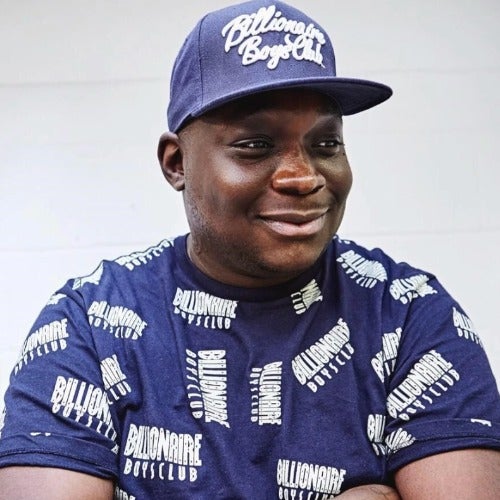
Grime—a musical, cultural movement birthed through East London’s underbelly in 2001—was never supposed to win, let alone last this long.
Fresh out the gate, the elder statesmen of UK garage, grime’s first cousin, refused entry to our tracksuit-wearing masters of ceremonies, leaving them with no other choice but to create their own stage to rep. Uncultured hacks and an even more out-of-touch British government were next up to bat, describing the sound as “angry”, “violent” and a real cause for concern. Add to that the boldly racist (now-scrapped) Form 696—a Metropolitan Police-assigned risk assessment form for venues and club promoters wanting to play music from the diaspora, but especially grime—and you could question how the genre’s mid-2010s revival was ever a thing.
Every bit the backbone of black British youth culture, grime has over the years been met with a lot of resistance—from its UKG bloodline to the authorities—which has allowed for other street-bred scenes, such as UK drill and Afroswing, to flourish in unimaginable ways. As with most genres in their infancy, grime has also hit its fair share of bumps in the road; however its biggest—and most damaging—were the “mainstream money” years. During these years, between late 2008 and the tail-end of 2012, we witnessed the scene’s MVPs—Wiley, Chip, Skepta and more—venture off into the unknown territories of electro and pop (remember when Tinchy went No. 1 with “Number 1” alongside N-Dubz?), in an attempt to win over the heart of the mainstream. For me, as someone who has championed the grime scene as a writer and club night promoter for many years, it was honestly a shame to see what was happening to our greats—it was if they had left the scene for dead.
Luckily, though, whilst this was going on, the likes of Jammer, D Double E, P Money and Jme—as well as the Birmingham scene (StayFresh, Jaykae, Lady Leshurr et al), and an instrumental scene led by the Butterz crew—were hard at work, flying the flag for this sound that we could call our own. Their efforts were always appreciated by us who wanted to see things back in their rightful place, but it didn’t always connect with fans on a wider scale. There was a general feeling that the scene’s MVPs no longer cared, which left a bad taste in most people’s mouths, and it would take for an unsuspecting emcee to come in and level the playing field.
Enter: Meridian Dan. In 2013, Dan, who had made his name in Meridian Crew alongside Skepta (and who famously featured on Skep’s “Private Caller” in 2005), didn’t have much of a catalogue to show for himself, but on his single “German Whip”, there was something about Dan’s choppy flow and co-stars Jme and Big H’s pirate radio energy that instantly connected with fans. Bleeding with early grime juice, the HeavyTrackerz-produced banger quickly caught a flame and spread across the ‘net and commercial radio in ways we hadn’t seen since Lethal B’s “Pow!” in 2004. “German Whip” was a wake-up call for everyone, and was the official start of grime’s second wave.
Skepta’s true return to form was up next, tapping younger brother Jme for the Eski-tinged “That’s Not Me”, which took things back to basics: skippy flows, hungry rhymes, and one killer beat. That was in 2014, but Skep had already showed signs of his renewed brilliance across his 2012 mixtape-album, Blacklisted (see: “Castles”, “Ace Hood Flow”).
View this video on YouTube
However, the emergence of Croydon’s Stormzy would catapult the genre to levels not even its originator, Wiley, had seen in his storied career. In 2015, backed by his boys in a South London park, Big Mikey (born Michael Omari) decided to pay homage to a classic riddim from the Ruff Sqwad camp—XTC’s “Functions On A Low”—by spraying lyrical venom all over it. The nostalgia “Shut Up” brought captivated millions (stats grime wasn’t used to seeing at the time), and right there and then, a star was born. This was also after gospel-loving rapper Kanye West decided to bring out Stormzy and half the grime scene to perform “All Day” at The BRITs, which was super random, but wholly appreciated: this move put the world’s attention on grime in a major way.
Not one to be outdone, a few months later, Drake, whose love for UK music and culture should never be questioned, popped up at a Smoke Boys (fka Section Boyz) show in Shoreditch and, for the second time in less than a year, British lyricism was the hot topic for hip-hop globally. Around this time, and even during the hype of “German Whip”, a fraternity of young, energised emcees—such as Novelist, Jammz, Big Zuu and Capo Lee—were making much-needed noise across online and pirate radio, injecting the stagnant scene with urgent flows and angst-laced bars that had all but disappeared. This lot didn’t care about the charts like the old guard—their music was made with the underground solely in mind, exciting critics like it was the first class of Deja.
Publications that would pass on my grime pitches were now bombarding me with commissions while, Stateside, this wrongly-dubbed ‘hip-hop subgenre’ was totally lit. It was all roadman this and roadman that (referring to how most of the artists dressed and moved); it had now become bigger than the music. And whilst grime was enjoying its time as a hot pop culture topic—and road rap legends such as Giggs, K Koke and Blade Brown continued to drop heat for the streets—a new movement, inspired by grime’s attitude and Chicago drill’s sound, was being forged in the same blocks that housed some of the UK’s biggest stars, and would receive the same exact treatment grime did in its nascent years.
“There’s been a lot of talk surrounding the cencorship of UK drill,” says Ben Wynter, Grants & Programmes Manager at PRS Foundation, who recently funded a drill rapper. “This period of UK rap reminds me of the way in which rap was received in America in the early ‘90s, censoring and banning the likes of N.W.A and Ice T due to the content of their rhymes. And whilst there is some coded language between some gangs on tracks—for the most part, these young rappers are only commenting on what they see around them. If the powers that be want the narrative to change, then it doesn’t start with censoring drill music—it starts with changing the socio-economic conditions these guys are exposed to.”
One of the more publicised cases in the banning of drill came in the form of Skengdo x AM, a rap duo from Brixton, and their track “Attempted 1.0”—which the feds placed a gang injunction on in 2018. Despite this ongoing fight to silence their voice, the pair have since released one of drill’s best projects to date in Back Like We Never Left.
View this video on YouTube
The arrival of Headie One, arguably UK drill’s biggest star, has been nothing short of refreshing. Switching up the formula of shank-em lyrics, clanging 808s and expected bass patterns, Headie’s latest project, Music X Road, has shown us that—while drill still has a lot of growing up to do—the sound’s future is promising. “Headie is culturally the most important out of the UK’s current crop of top rappers,” Rob Uche, Senior A&R Manager at Sony imprint Relentless, says of his signee. “I first came across Headie via the video for ‘How Many’ in 2017, and then I just looked out for the Drillers & Trappers mixtape. When I heard it, I knew he had something special about him; the diversity of his flows on the opening tracks made me an instant fan.”
While being independent is still very much celebrated, signing to a major is no longer a jab for “sellouts.” Since 2016, thanks to grime’s revival and culturally-conscious A&R execs replacing novices, major labels have enjoyed more success with black British talent than ever before.
For Uche, having the right people at the helm is key. “We have one of the most exciting music scenes right now that I can only see progressing with the right guidance,” he says. “The industry respects success and when they see it, they are forced to acknowledge. On our side, we need to focus more on identifying top-quality talent and for them to be nurtured by talented and hungry A&R execs that are passionate about developing more rounded artists and elevating the overall quality of the music.” Akua Agyemfra, a brand and marketing exec who works with the likes of Stormzy and Wretch 32, believes that teamwork makes the dream work. “It’s exremely important to have a team around you that are all thinkers and strategists,” she explains. “Having people who have your back and think holistically is very important—a team that thinks about who, and what, an artist is going to be long-term.”
In a year that has seen Stormzy headline Glasto, drill artists level up, and sharper-than-sharp albums from the likes of Kano (Hoodies All Summer), Skepta (Ignorance Is Bliss), Wretch 32 (Upon Reflection), Dave (Psychodrama) and Little Simz (GREY Area), it wouldn’t be far-fetched to say that UK lyricism—in all its forms—is the healthiest it has ever been. “If everyone understands and harnesses their power in the right way,” Akua adds, “there are no limits to what else can be achieved.”



